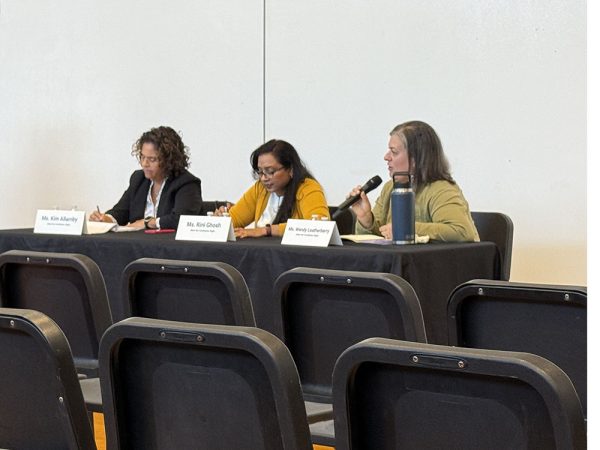Cleveland Protests the Floyd Killing
A mother and daughter share their story of the May 30 protest
Protests have broken out in cities across the country since May 25, when George Floyd, an unarmed black man, was killed by Derek Chauvin, a white Minneapolis police officer.
Floyd was accused by a convenience store cashier of paying with a counterfeit $20. Chauvin, along with officers Tou Thao, J. Alexander Kueng and Thomas K. Lane responded to the incident.
Chauvin knelt on Floyd’s neck for eight minutes and 46 seconds while two other officers pinned Floyd down and witnesses called for help and filmed the incident.
Thousands of Clevelanders gathered downtown on Saturday, May 30 for a protest that started peacefully but led to confrontations with police and looting.
One 41-year-old Mayfield resident, whom we will call Nia, attended the protest with her daughter, whom we will call Jada. Both women did not want to use their real names for safety reasons.
Nia stated that she went to the protest to support her daughter, and that it was her daughter’s idea.
“[I] went with [my] daughter [who is 15] and her best friend [who is 16],” Nia said. “[We] parked on West 6th and Ontario [and] walked down West 3rd across Lakeside to the free stamp at 2 p.m.”
“There were tons of people… as they were rallying they started marching down to the Justice Center,” she continued. “[I] noticed immediately a white guy who had long hair, long beard, [and] looked like a biker, angrily yelling ‘F the police,’[which] was strange.”
“[We] practiced social distancing as much as [we] could, and [we] weren’t among the crowd,” she added.
Jada was nervous on the day of the protest.
“I wasn’t sure about how the evening would play out…” she wrote in an email. “Throughout the protest there were plenty of speeches where we stopped marching. A lot of the speeches talked about the injustice with the police and…[described] more cases of police brutality.”
Nia said that her emotional response to the George Floyd case was extreme sadness, disappointment, anger and rage.
“How many people does it take?” she asked. “…It is impossible to ignore that African American people are treated differently.”
She explained that protesters are motivated by the long-term trauma of police brutality.
“People are hurting, and there are [too many] people that are hurting who have had enough,” she said. “People just want things to be fair, which can cause things to boil over and go from anger to rage really quickly.”
Jada responded to the Floyd killing with confusion and extreme hurt.
“Everything was caught on camera, and I couldn’t [bring myself] to see that police officer kill an innocent man,” she wrote in an email.
“The [prevalence of] police brutality and racial inequality breaks my heart and is something I’m very passionate about,” she added. “So when I found out there was a protest, I wanted to go.”
Nia found the protest to be a very emotional experience.
“[It was the] most emotional thing [I’ve] ever been through outside of childbirth,” she said. “[And I didn’t know] how to process how [I] felt.”
“[The protest] made [me] think about [my] own blackness and how [I] excused people’s behavior [or] took the high road and stayed silent [and] didn’t do anything about [their behavior],” she continued. “[I have] no problem speaking up for myself [or my] children, but sometimes [I] just let things slide.”
“[The protest] made [me] aware [of] how many people around [me] could come together for a cause,” she said.
“I paid attention to the signs,” she added. “The people there were every shade, and [there was a] wide variety of different types of people: small people, older people, young people [and a] guy who couldn’t even stand up straight had a sign.”
Nia explained what happened as the crowd approached the Justice Center.
“[We were] across the street… [and it was] difficult to know who was in charge.” she said. “[There were] so many people that you couldn’t hear the direction of the person who was speaking.”
“Very quickly [I] could see people throwing food, containers, water bottles at the Justice Center [and] the shaking of the [Justice Center’s glass] from people pushing on it,” she continued.
Nia and Jada and Jada’s friend returned towards the free stamp, but a larger crowd of protesters remained at the Justice Center.
“[The] people in charge attempted to redirect the crowd up to West 6th back to the free stamp,” Nia said. “One thing [I] noticed [was] the further we walked, the more spread out the crowd became. Little bits of the crowd were left everywhere [and there was] significantly fewer people than [we] had started with when [we] returned to the free stamp.”
At that point, the atmosphere had become more dangerous.
“[We didn’t] go down to the Justice Center [because the police were] shooting tear gas and rubber bullets,” Nia said. “[We] had masks and face shields on [and] headed to the car.”
“[We] were parked on Ontario [so we] couldn’t walk down Lakeside at all,” she continued. “Once [we] got on Ontario there [were] billows of smoke.”
“We walked down one block towards Ontario, and the tear gas started to blow in [our] direction. [We were] trapped when walking toward Public Square,” she added. “[There was] so much tear gas coming from a block and a half away that it was ridiculous.”Fortunately, they were able to return safely to their car.
“[The] crowds became rowdy and violent,” Nia said. “[There were] clusters of people instead of one large [group]. At Public Square [we were] hiding behind buildings to avoid tear gas.”
“When [we] finally [got] down to West 3rd, [we] could see police cars on fire,“ she continued. [We were] coughing and sneezing from tear gas [and it was] hard to breathe.”
“[We eventually got] to our car,” she added. “[We had] prepared [by bringing] hand wipes, hand sanitizer, extra water bottles, so [we] could pull themselves together. [Then we] drove home.”
Nia also stated that she never saw aggression towards police officers at the Cleveland protest, and stated that the protest was peaceful prior to the confrontation at the Justice Center.
“[The protestors were] destructive towards property, and not toward the police [officers] themselves at the Justice Center,” she said.
“[I] didn’t see looting, but [I did see] violence [and people] being destructive,” she said. “[We] left [before] they started smashing windows [and] businesses.”
Nia also stated that she didn’t witness any police violence or police officers being disrespectful, and that she was never hurt, harassed, or belittled by anyone at the protest.
“The police officers I saw were more firm and direct,” she said.
Jada described her own perspective of the protest.
“A lot of [the police officers] were stone faced and didn’t pay the protestors any mind if someone yelled at [the police officers] or put their middle finger towards [the police officers],” she said. “I didn’t see any violence or looting, but then again, I left as it started to get violent. I was never harassed…”
However, attending the protest was clearly risky. Police reportedly launched tear gas, flash grenades and pepper spray into the crowds of people.
Nia acknowledged that things were tense during the protest.
“[We] got caught by [the] tear gas [and the] rioting [was] on the same street [we] were parked on,” she said. “[We] had to go into [the violent] area to get out. [I] was afraid [I] was going to get shot with rubber bullets.”
“The tear gas makes your eyes water [and] burn, and the more you rub the more it burns, [so we] couldn’t see well [and we] couldn’t identify threats,” she added. “[Not having] all senses in an intense situation adds to fear, [but I] never felt afraid during [the] protest. [The] only time {I] felt unsafe [was} when [I] was trying to leave.”
Jada stated that she was afraid when the tear gassing began.
“I was terrified that I would suffer from the effects of tear gas, because at one point we were trapped where the police began to throw the gas,” she wrote.
Nia feels that the media portrayal of the protest focused on the negative.
“[The] media shows fire, doom, and destruction,” she said. “[The protestors] took a knee during the protest, and that wasn’t shown.
Jada also stated that her experience at the protest was different from how the media portrayed it.
“A lot of people make it out as if the protestors did something to provoke the police, but it was a PEACEFUL protest. The only non peaceful part of the protest is when a few people threw rocks at the Justice Center, and even then it didn’t last long and nothing broke or was damaged, she wrote. “After [the] news [spread] that people were being tear gassed at the Justice Center was when the riots broke out, but before then the whole protest was entirely peaceful.”
Business owners who have already taken a hit from the coronavirus lockdown now face rebuilding after the damage caused by vandalism and looting, according to Cleveland.com.
Nia has mixed feelings about the looting in downtown Cleveland.
“I don’t think that looting or tearing up businesses inside of communities is a positive way to express yourself,” she said. “[But] what looting did was provide enough noise to start realistic conversations about reparations and sheer equality.”
“Often, black people have been animalized and criminalized… [I hope] this amount of noise brings awareness that is needed [and] this movement will not be wasted,” she added.
“Even when just one [black person] tears up something inside our own community it gives non-black people permission to believe the stereotypes,” she continued. “We have to continue to make noise, [and I hope] that we can make noise in a way that doesn’t have to be destructive.”
She also emphasized that vandalism and looting frequently harms the very people that protesters want to help.
“When the closed sign is turned you can’t tell what color the business owner is [and it is] very hard to determine what business is black or what business is white,” she said. “[When] you destroy Walmart or target those stores no longer want to service that community [and] communities that experience rioting [and/or] violence usually don’t survive. If Walmart is looted, [Walmart] may have to shorten their staff or close.”
“[What] about the janitors that have to clean up or the people that have to scrub the ‘F the police’ off the wall?” she asked. “99% of the time those people are black.”
“Stealing has nothing to do with this [cause],” she continued. “[I do] understand why people loot [and] why people want to destroy because anger and rage are mere images of each other. [So I] understand it, [but I don’t ]condone it.”
“[I have] a business and insurance, if I had to close [my] business then the people that help contribute to [my] business won’t be able to get paid,” she added. “Taxpayers will have to pay for [the] police car. [Destruction is] not productive.
Jada also understands the rage, but disagrees with the looting.
“[The looting] defeats the purpose of the protesting,” she said.
After eight days of protests, Derek Chauvin’s murder charge was upgraded to second-degree, and the other three officers involved were charged with aiding and abetting second-degree murder and second-degree manslaughter.
Nia is glad that there has been some action taken against the officers responsible for Floyd’s death, but she does not feel that justice has been served.
“All of the police officers involved including the Asian police officer that watched should go to jail,” she said. “[Derek Chauvin should be given a] 1st-degree murder charge [and the] death penalty [or] life in prison especially considering he has a history of violence toward black people.”
“The other three police officers should be charged with accessory to murder,” she added.
She feels that without meaningful consequences, the problem will persist.
“This continues to encourage a community of police officers that aren’t even policing themselves,” she said. “When you… don’t even acknowledge that the people you are working with are human, [that] creates a problem. “
Jada also feels that the consequences for the officers have been inadequate.
“All of [the police officers] should be in jail for a very long time without parole,” she wrote. “It is sickening that everyone else sees an innocent black man get murdered, yet the court of law sees a man get killed [as being a third-degree murder charge].”

Brooklyn Hollimon (she/her) began writing for the Beachcomber in the spring of 2019. She enjoys covering school and community events. Outside of the Beachcomber,...







![“My parents have always said that education is important. My parents are Chinese immigrants, I'm Chinese American, [and that's a] value that has always been ingrained in our community,” said Senior Lyndia Zheng, pictured with Tony Zheng](https://bcomber.org/wp-content/uploads/2025/10/DSC_4244-600x400.jpg)


